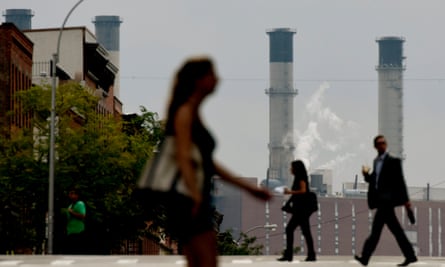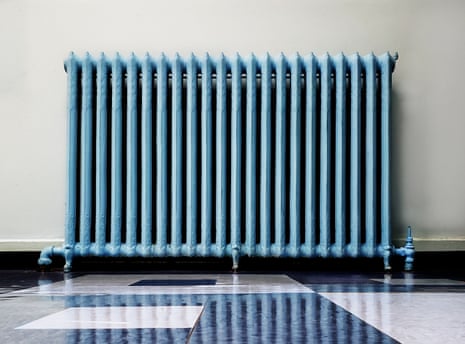Until recently, my girlfriend and I lived in a steam-heated apartment in Manhattan. A creaky former tenement building, it had no radiators, just scalding-hot cast iron pipes that punched through the units like fire poles. The pipes terminated a few inches from our ceiling with valves that hissed and sputtered, leaking rusty orange water. And they weren’t just heaters, but alarms, clanking like pots and pans every morning around 6.45am when the boiler flipped on in the basement.
This 19th-century technology certainly heated our apartment – but far too well. So every wintertime we would have to throw the windows wide open just to cool down. (My girlfriend enjoyed the contrasting sensations, like ice cream on warm pie. “It always felt like a big waste of energy, but it was pleasant in its own old-school New York way,” she says.)
Indeed, steam still heats as many as 80% of New York City’s residential multifamily buildings, according to the non-profit Urban Green Council, as well as millions of homes across the north-east and midwestern United States – what the nonprofit calls the “steam belt”. That means, in a climate emergency as energy prices spiral, tens of millions of Americans are probably opening their windows all winter to let cold air in because their homes are too well heated.
Why on earth is it this way?
Many of America’s ageing steam systems are oversized or miscalibrated. According to a 2019 report by the Urban Green Council, 73% of tenants in steam-heated buildings are chronically overheated. And while 63% reported opening their windows to cool off, the systems are “so unbalanced that other residents in these same buildings don’t receive enough heat”, the report wrote. But policymakers’ greatest concern is pollution: buildings are by far New York City’s largest source of carbon emissions, and 62% of the fuel burned by the city’s residential multifamily buildings goes to heating steam, the report found.

That could begin to change in a few weeks, when a new energy efficiency law in New York takes effect, enacting the first step in what will be a gradual phaseout of steam heating. OK, but what took so long?
Steam, I learned, has stuck around because it’s simple. A basement boiler heats water into hot vapor, which naturally rises through the building through pipes, usually to coiled radiators, which release the heat into surrounding air. The cooled vapor turns back into water, and gravity returns it to the boiler. There’s no need for temperature controls in each home because the boiler is pre-sized to deliver just the right amount of steam to each radiator. Keep that cycle steady, and everyone stays toasty.
But generations of neglect have disrupted the careful balance of these systems – and now nobody remembers how to fix them. The veteran heating expert Dan Holohan, who worked as a heating parts salesman in the 1970s, remembers how contractors were puzzled by steam equipment even back then. Post-second-world-war buildings had switched to newer methods like furnaces. Most earlier steam experts were retired or dead, and Holohan assumed the technology would die soon, as well.
Curious, he began digging up old steam heating documentation and “fell in love”, he says. “There was so much American history wrapped up in it.” From the beginning, the designers of steam heating “were making it up as they went along”, he realized.
Once considered a luxury, and infamous for constantly exploding boilers, steam heating enjoyed a massive surge in popularity around the 1918 flu pandemic. In response to a “fresh air movement” to fight the virus’s spread, crowded tenement buildings installed steam systems that generated enough heat that residents could leave their windows open, even in the dead of winter. “This is why the radiators are as big as they are,” Holohan explains. “And they’re pumping out all this heat to this day.”
The 1920s and 1930s were what Holohan calls the “golden age” of steam heating. Having figured out how to prevent boiler explosions, technicians began designing intricate steam systems that were as efficient as they were powerful. They realized steam, virtually weightless, was unparalleled in its ability to distribute heat to the top of skyscrapers, like the 102-floor Empire State Building. That insight holds today: even New York’s One World Trade Center, finished in 2014, is heated by steam.
Steam heating’s problems developed in the 1970s, Holohan says, after the first Opec oil embargo. Faced with energy shortages, the government enacted new regulations requiring more efficient boilers. Many buildings resized their boilers without also replacing their pipes and radiators, throwing the systems badly out of balance. More issues arose when buildings replaced old windows with better-insulated ones that trapped too much heat. Meanwhile, “the old-timers were dying, not being able to teach the young people coming in”, Holohan says. But landlords, concerned with cost, opted to muddle through rather than overhaul their systems, deciding that tenants would just have to put up with the banging, gurgling and wild temperature swings.

And, for nearly half a century, we (mostly) have. But we’re running out of steam. In 2019, New York passed Local Law 97, a measure to curb greenhouse gases produced by larger buildings in the city. The law takes effect in two months, creating limits that are scheduled to get progressively tougher until 2050, when the city hopes to have achieved complete carbon neutrality. That means steam’s days are officially numbered here. “To fully decarbonize New York City, we can’t have fossil fuel combustion in buildings,” says Adam Schiabor, research manager for the Urban Green Council. “But we’re talking about a complicated and old building stock, so it’s certainly going to take a few steps.”
The long-term goal is to get buildings to switch their steam systems out for electric heat pumps – a modern, energy-efficient heating and cooling system that transfers heat between indoors and outdoors. (I moved to a new building last year that uses heat pumps; the difference in comfort is incredible.) In the meantime, Schiabor says that buildings can make “no-brainer upgrades” to their old steam systems: vents, temperature sensors and valves that would improve performance, while giving residents more control over the temperature indoors – and presumably letting them shut their windows in the wintertime. Still, some landlords are resistant. A group of homeowners recently sued the city over Local Law 97’s “onerous” demands, though a judge tossed the suit.
Holohan, now 73, says he agrees with the new regulations. But he believes steam could offer the city the efficiency it’s looking for – if people could just learn to use it right. Before he retired, Holohan helped a historic Manhattan building tune up its steam system, which was “gorgeous and original to the 1890s”, with “extremely beautiful” radiators. “The system is absolutely quiet. It’s very fast. It’s extremely efficient. We did that, and it gets no attention.”
